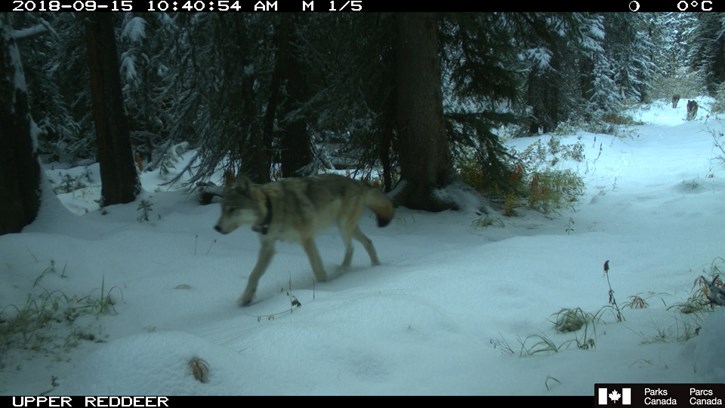BANFF – The breeding female of the Red Deer wolf pack was caught and killed in a snare on provincial lands – the second research wolf in Banff National Park to be killed in a trap line in as many months.
The wolf, which produced at least four pups last spring and was said to be healthy before her death, was fitted with a GPS collar to help with park research associated with the bison reintroduction program.
Parks Canada wildlife officials say the animal’s GPS collar let off a mortality signal on Jan. 19, adding they don’t know if other wolves of the eight-member pack were trapped.
“Staff hiked to the area and picked up the collar and the wolf had been caught in a snare,” said Jesse Whittington, a wildlife ecologist with Banff National Park.
“We know trapping is a hazard that wolves face when they travel outside the park.”
The five-year-old breeding female wolf was snared along the Panther River less than one kilometre from where a wolf from the Panther-Cascade pack was trapped in early December, about six kilometres outside Banff National Park in Bighorn Country.
The death of that wolf left one remaining animal in the Panther-Cascade pack.
A second wolf in the Red Deer pack has a collar, but it is no longer uploading data to satellites. The collar may still be collecting data because the ground-based VHF signals sound normal.
“That wolf was not trapped,” said Whittington.
Paul Paquet, considered one of the world’s leading wolf experts, said another Banff National Park wolf caught lawfully in the province is unsurprising, but “disappointing and appalling.”
Paquet has long argued snares are the most inhumane, legally allowed traps in use, even used by the provincial government to kill wolves in the name of protecting caribou, which have suffered as a result of industrial development.
“Will this ever end?” said Paquet, who is an adjunct professor of biology and associate professor of environmental design at the University of Calgary
“In this case, it’s especially offensive because dying by slow strangulation is such a horrific way to die and undeniably inhumane.”
The Alberta Trappers’ Association estimates trappers kill about 1,000 wolves a year in Alberta.
Bill Abercrombie, the group’s president, said although it’s unfortunate that collared research wolves are being caught, trapping is legal in Alberta.
“The trappers’ intent is to manage a sustainable population. We’re not there to catch all the wolves by any means. It’s our desire to have a healthy sustainable population of wolves in Alberta in the long term,” he said.
“The reality is, the best way to do that is manage the numbers so they don’t become overpopulated to the point that they have a really significant impact on game populations and food sources and also not too much conflict between wolves and livestock producers.”
There’s a requirement for trappers to check their lines every 48 hours if they use a restraining trap, but Abercrombie says there’s no timeline for checking if it’s a snare.
“If you’re using a lethal killing device, like a snare, the government has not imposed a rule because the reality is trappers tend to check frequently anyway,” said Abercrombie.
“Any animal that is in the bush is going to get eaten by something else anyway, so trappers have to be there regularly to salvage the pelt.”
A spokesperson for the province could not be reached for comment before press time.
The Red Deer wolf pack ranges from Ya Ha Tinda to the Icefields Parkway. It spends about 80 per cent of its time inside Banff National Park.
GPS tracking data shows the pack has spent most of the winter in the Red Deer River Valley and surrounding areas, and in mid-January travelled into the Panther River Valley and out of the national park where it spent a few days.
“In the winter the deep snow constrains prey to lower elevations, which in that area is the eastern part of Banff and out on the eastern slopes,” said Whittington.
Whittington said the breeding female wolf was initially collared as part of the bison reintroduction project on the eastern slopes of the Rockies.
He said they plan to radio-collar wolves from the Red Deer and Panther-Cascade packs later this winter, but it will depend on how many wolves are in the packs.
“We wanted to know how wolves might affect bison movements and how bison might influence predator-prey dynamics between wolves and other prey species,” he said.
“Since bison were released, the collared wolves regularly investigated the bison, but did not appear to trigger large movements as bison are big animals and difficult to predate. However, over time wolves may learn how to predate on the small or weak animals.”




